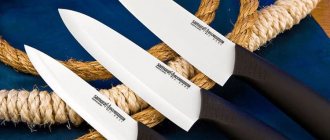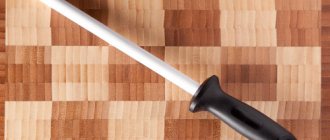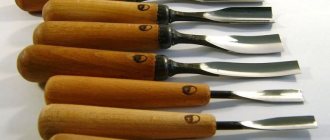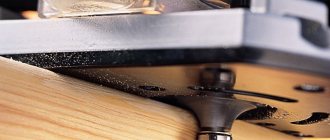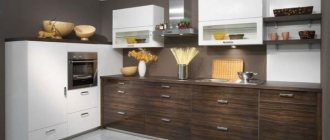Types of sharpening stones
There are several types of stones that are used for sharpening knives:
- Oil-based - such stones involve the use of oil on the surface, which saves material consumption.
- Water stones - have the same principle of operation, but water is used to work with them.
- Natural stones are natural materials that have been industrially processed.
- Artificial stones, accordingly, are made from a non-natural component.
- Rubber stones, such material is rare, as they are not convenient to work with.
Basic principles of sharpening
When properly sharpening a knife, the main condition must be met - the formation of a sharp edge of the blade while maintaining its shape , which is ensured by removing the metal at a certain angle.
Turning is carried out with an abrasive material that has different grain sizes. Its choice is determined by the strength characteristics of the steel. Proper sharpening implies a certain order of work.
Sharpening angle
The effectiveness and quality of the event under consideration is limited by a fundamental parameter - the sharpening angle. Depending on their purpose, knives have the following meanings:
- Straight razors have the smallest angle – (7-11)°;
- fillet knives – (11-14)°;
- kitchen knives for most products, incl. bread, vegetables, meat, etc. – (16-21)°;
- hunting tools and knives for general technical purposes – (21-26)°;
- universal hunting knives – (21-40)°;
- a special tool that is used for cutting and chopping (for example, a machete) – (29-50)°.
The sharpening angle largely determines the thickness of the blade. At the smallest angles it should resemble a razor, and at large angles it becomes possible to manufacture especially strong, massive knives.
Important. Holding the abrasive element and the knife itself in your hands, it is very difficult to ensure a given angle along the entire length of the blade, which leads to uneven manual sharpening.
The main task of the device is rigid fixation of one of the elements and a clear direction of movement of the second element.
We recommend: Wood sander - which one is better to choose? Rating of popular models and manufacturers
Types and choice of abrasive
To sharpen knives, you need an abrasive stone , which will ensure the necessary cutting of metal. The abrasive ability is provided by a certain surface grain size, i.e. the number of abrasive grains per unit area. According to this parameter, the following stones are distinguished:
- very coarse abrasives (international classification - extra coarse) - have a grain size of less than 260;
- coarse abrasives – 310-360;
- medium abrasives – 390-510;
- fine abrasives – 590-720. This is the main category of sharpening stones used for cutting knives;
- very fine (ultra, extra fine) or grinding abrasives. They are used for sharpening razors and fine surface finishing of knife blades.
According to the nature of their origin, abrasive stones are divided into natural or natural (corundum, slates) and artificial (ceramics, artificial diamond). In addition, rubber elements are sometimes used for fine processing. When using abrasives, their surface is moistened with water or a soap-water solution (water tool), as well as oil (oil stones).
The shape of abrasives can be round (discs) or rectangular (bars) . The most commonly used bars are bars, and they are selected so that the length significantly exceeds the length of the knife blade .
To fully sharpen the tool, it is recommended to have 2 bars of medium and fine grain. It is better to complement the set with a very small stone. The best option is to use double-sided bars, in which one side has a medium grain and the opposite has a fine grain.
Manual sharpening procedure
Any devices are designed to facilitate work and improve its quality, and the general procedure for manual sharpening remains the same:
- The process begins with a coarse or medium-grained bar, which is laid on a plane. It is advisable to ensure its fixation.
- The knife blade is brought to the abrasive surface at an angle equal to half the sharpening angle. The main task is to ensure a constant angle throughout the event.
- With a smooth movement with light pressure, the blade moves from the beginning to the end of the block in the direction “away from you.” The edge of the bar must always be perpendicular to the direction of movement of the blade. Do not allow the blade to break off at the end of the stone.
- After reaching the edge of the bar, movement is carried out in the opposite direction, while the sharp edge must always be on the surface of the abrasive. Changing direction is achieved by turning the handle.
- The process is repeated until a burr along the entire length appears on the back of the blade tip. It should move to the opposite side when changing direction.
- Next, take a medium-grained block, but with smaller grains. Sharpening continues, but the movements are carried out initially only “from oneself” until the metal shines on one side, and then the second side is also processed.
- A fine-grained block is taken and the blade is processed until a mirror surface appears.
- If a small burr remains, sharpening is completed by using a very fine grit sanding block. Some experienced people prefer to use a leather belt . It polishes the knife blade perfectly.
Recommended: How to choose a good quality bubble level? Setting and adjustment, how to set the level during operation
Some features of knife sharpening
Each knife has its own sharpening feature.
For example, a Japanese knife, for self-sharpening, requires the attention of an experienced craftsman, since Japanese steel is very fragile. Manufacturers recommend using several types of Japanese water stones with different grain sizes for sharpening.
For housewives, it is easier and more convenient to use a special sharpener to sharpen a kitchen knife. However, using several stones will keep the knife sharp for a longer time, which is especially appreciated. Although this will take more time and effort, it will extend the life of the tool.
Why does the knife get dull?
Sharp objects are dangerous because you can get hurt when using them.
But even more trouble will come from a dull chef's knife, which can slip and easily injure your hands. Following a number of recommendations will help keep your kitchen knife sharp longer:
- during storage, the cutting edge should not touch surfaces that have a high density;
- cutting should take place on special boards made of wood or plastic;
- blades of all types must be used for their intended purpose, avoiding shock loads on blades whose sharpening has a small degree;
- Immediately after use, knives should be washed and dried.
The sharpness of the cutting edge decreases for several reasons:
- Impact of organic acids contained in products on the blade material.
- Impacts from a fall.
- Cutting on hard surfaces such as stone countertops or ceramic cookware.
- Uneven load on the cutting blade when the composition of the products is uneven (the blade hits bones, tendons when cutting meat).
- Exposure to aggressive chemicals and high temperatures during cleaning.
- Improper use.
If the knife is intended for cutting the fillet of fish, then when opening cans with it, the blade will be damaged. The nature of the RK violations depends on the material from which the blade is made.
Carbon steel has increased strength, such blades are more difficult to sharpen, but they retain their sharpness longer. With insufficient care, the metal quickly becomes covered with rust.
By combining hard and soft steel in industrial production, alloys are created that imitate the blacksmith forging inherent in Damascus blades. Knives are made primarily for hunters using this method.
Products made from zirconium alloy are characterized by increased fragility. These ceramic knives are designed for smooth, soft products and keep their blade sharp for a long time. A special tool is required for sharpening.
Calculate the angle of descent on the knife.
Conditions for proper sharpening of knives
To properly sharpen a knife, it is necessary to create conditions under which the knife will remain sharp for several months. For such sharpening, choosing the right angle will help. There is a rule that determines the correct principle of operation - a smaller angle for sharpening a knife will create less strength of the cutting edge. That is, it should be remembered that the sharper the knife is immediately sharpened, the faster the time will come for re-sharpening, and the more difficult it will be to bring the knife to its original working condition.
Problems that may arise when sharpening
Without a doubt, to select the appropriate angle, experience is required, without which it is quite difficult to cope with this task. Moreover, without the necessary equipment, since holding the knife with your hands makes it difficult to sharpen it evenly on both sides. To eliminate the problem, it is recommended to build a homemade knife sharpening machine, which is easy to make at home. After all, the existing devices are quite simple in design and are not distinguished by their complexity.
What problems may arise during the work process?
Of course, choosing the right angle for sharpening is difficult. Moreover, such a process is difficult if there is no special device for sharpening knives. After all, if you hold the blade with your hands, it will be very difficult to achieve a uniform sharpening with the correct angles. To eliminate this problem, you can use a homemade knife sharpening device. Moreover, making it at home is not difficult. And although there are currently a huge number of different sharpening devices, their design is not particularly complex, so it will take little time to manufacture such a device.
How can you sharpen a knife at home?
There are situations when you need to sharpen a knife very quickly at home; for such purposes you can use the following available materials:
- wooden block;
- hacksaw;
- sandpaper;
- file;
- ceramic plate;
- chisel and some others.
Particularly sophisticated village men can generally sharpen a knife on a foundation made of a solution of cement and sand. However, it is not recommended to follow this example, but to use in practice the most proven methods that are suitable for quick sharpening.
The best way would be to make a homemade device, since it is effective and very convenient, and besides, it will differ little from the factory one.
Grinding stone grit
Abrasive whetstones differ in grain size. There is a conditional division: small stones, medium stones and coarse stones. The accepted classification is numbers - the number of grains located in a unit area. Some manufacturers (for example, Chinese) make duplicate inscriptions in English for the convenience of customers.
- Extra coarse: 200-250 - extremely coarse. They are completely unsuitable for sharpening knives.
- Coarse: 300-350 - rough. These stones are used only for severely dull or damaged blades.
- Medium: 400-500 - average. You can get by quite easily without an abrasive of this grain size.
- Fine: 600-700 - small (thin). This is the most popular type of whetstone for sharpening knives, including at home.
- Ultra/extra fine: 1000-1200 - very fine. They are used for final processing of the blade, which they want to bring to shine.
Sharpening stones should have a convenient shape. It is optimal if the length of the stone significantly (1.5-2 times) exceeds this parameter of the blade. The most practical products are those that have different grain sizes: coarse on one side, fine on the other. For ordinary household knives, a modest set of sharpening stones will suffice. It consists of 2 medium-grain bars (different) and the same number of small-grain stones, one of them can be ultra-fine.
The bars differ in origin. Natural sharpening stones (corundum, slate) have several disadvantages - quick grinding and, as a rule, the absence of fine-grained products. These materials are soaked (or just wetted) in water before work. After this procedure, an abrasive paste is formed on the surface, which guarantees greater sharpening efficiency.
What are the drawings for?
Of course, purchasing a ready-made knife sharpener is much easier, and they are not so expensive. Still, most home-conscious owners prefer to do everything with their own hands, this is pleasant and you can be confident in the quality of workmanship. After all, only natural materials are used. To make the manufacturing process enjoyable and simple, you need to prepare a plan and follow it.
- To begin with, a ready-made drawing for the clamping jaws is made or purchased. When making a drawing, it is necessary to pay special attention to the smallest details and think through and draw the entire structure.
- The next step will be to draw a drawing of the right and left stops, for the strength of the assembled structure.
- Make a drawing for a guide, which has its own subtleties.
Guide drawing
All you need for a guide that will fit perfectly is the following:
- A spool with an M6 thread, which must be sawed off using a hacksaw so that it is 16 cm long. The main thing is to ensure that there are no burrs so that they do not slow down the sharpening process itself.
- Also, electrodes with a soft and elastic cylinder can be useful in work; they must be bent into the letter “g” using pliers. The main thing during the work period is not to forget to periodically look at the product drawing.
- Metal scraps are useful for using clamps; they need to be cut and holes installed using a drilling machine. A hand tap will help in marking the threads. And in order to reduce friction, use a drop of oil, which can subsequently be easily removed with a soap solution.
- When finishing work with the guide, according to the drawing, you should twist all the parts and, for fixation, drop regular nail polish onto the junction of the clamp and the pin.
Useful tips for quality work
There are two types of knife sharpening: double-sided and single-sided. The operating principles of these two are, of course, different. All that needs to be taken into account when working with knives are criteria such as:
- The abrasive stone used when working with knives should not have very fine or, conversely, very large grains; choose something in between these two criteria.
- In the case when there is no necessary device for sharpening a knife, and the tool needs to be sharpened, you can use a handy tool such as a ceramic mug. All you need to do is turn the spontaneous sharpening over and move it towards you along its bottom. But it is worth considering that its bottom should have a rough surface.
- Don't forget that ceramic knives do not need sharpening. Their surface is coated with a special coating made of special alloys, which protects it from damage and wear.
- A serrated knife should not be sharpened without special equipment; there is a high probability that you will not sharpen it, but will ruin it. For this kind of knives, a special laser is used.
- To keep knives sharp longer, they should be washed in cold water.
Knife sharpening errors
How to make a homemade knife sharpener
All homemade knife sharpeners solve the main problem - they allow you to accurately maintain a given angle of inclination of the block to the blade, which is very important for obtaining a good cutting edge. There are very simple devices, and some are a little more complex, but they allow you to work with greater comfort. Choose according to your taste.
Some of the options are from improvised means
A simple device for sharpening knives
Essentially this is a holder for sharpening stones. Everything is elementary: two triangles made of wood, which are connected by pins with wings. A block is clamped between the corners at the required angle. You can set the angle using a protractor, a special program on your smartphone, or using the rules of trigonometry (right triangle).
Knife sharpening device - abrasive holder
When sharpening on such a device, the knife must be kept pointed strictly vertically at all times. It's much easier than holding it at a certain angle.
The same idea has another embodiment: on a reliable basis, make movable holders into which bars are inserted and secured in the desired position. The corporate prototype is pictured below.
Holder for whetstones when sharpening a knife
A homemade device for sharpening knives is made of wooden blocks. It turns out to be light, so that it does not move from its place, it needs to be fixed with something. To avoid holding with your hand, you can use clamps.
Rotating holders allow you to set a given angle, and then fix it with the help of “wings”
Such a device for sharpening knives, of course, makes the work easier, but it is still quite difficult to maintain the angle: you must constantly control the verticality of the blade. Such a habit can be developed over time, but starting is difficult.
Device on wheels
An interesting version of a manual knife sharpener with a fixed block and a wheeled cart on which the knife is mounted. It is made on the basis of sharpeners for knives, chisels and planes. This device also works well with a knife, but you need to get used to sharpening a rounded edge.
Homemade tool for sharpening knives on wheels
In this version, as in manual sharpening, the block is stationary, but the blade of the knife, mounted on a movable trolley, moves. The angle is set by the height of the bar relative to the platform on which the blade is mounted. The peculiarity of this device is that the table must be level. It can be a tabletop made of natural stone, or you can put glass on a regular table.
In the version presented above, the angle changes slightly, which is usually sufficient for sharpening similar types of knives - kitchen knives, for example. If necessary, the design can be improved by adding holders (pictured below).
Improved model
All this is implemented very simply, as it resembles a regular construction set: strips with holes in them, everything is assembled with bolts and screws.
There is also a device to ensure the immobility of the block.
To fix the bar
The advantage of this whole design is that it is easy to unfold the knife while maintaining perpendicularity on the rounded area, and it is also very easy to handle on the other side: you need to turn the cart over. For this purpose, four pairs of wheels were made.
Homemade manual machine for sharpening knives
Slightly more complex and much more convenient homemade devices, which are made on the basis of well-known branded devices. They have an adjustable platform on which the knife is fixed. The site is set at a given angle. The block is mounted on a movable rod attached to the stand.
One of the branded knife sharpening devices
Self-made devices in some ways repeat the design presented above, but there are some differences. There are many options. Let's give some.
Option one: a fixed platform on which the blade is fixed
This device is made from leftover laminate (chipboard can be used), two steel rods with a diameter of 8 mm and a movable fastener.
General view of the device for sharpening knives
This design has a fixed base, to which a platform with a knife lock is attached on regular hinges. The near edge of the platform can be raised at some angle convenient for work. But otherwise she is motionless.
On a vertically mounted steel rod there is a movably mounted latch, in which a loop is attached to the side. A rod is inserted into it, on which the block is fixed. This loop is a simple, but not the best solution: there is no rigid fixation, which means the angle will “walk.”
Loop into which the second rod is inserted
Particular attention should be paid to the bar lock. An emphasis is placed on the rod at some distance from the edge (about 30-35 cm). This will be a permanent fixture. The second one is made movable; it is fixed after installing the bar using a screw and a thread cut into the body of the holder. The second option is to cut a thread on the rod and tighten the installed bar using a nut.
Knife holder - one or two steel plates mounted on a movable platform. They are fixed movably using screws and wings. Having loosened the fasteners, insert the knife blade and clamp it. It is very difficult to move it. Then, installing a pin with a fixed bar in the loop, adjust its height so that the required angle is set.
Setting the angle
You can, as in the photo, make templates with the required angles and ensure that the planes match. After the crossbar is secured, you can work - move the bar in the desired direction.
This device for sharpening knives works well, but you can only move the abrasive along the blade when sharpening a kitchen knife. Classic sharpening - movement perpendicular to the cutting edge. This can be achieved on the straight part of the blade. If the blade is short, this will be almost perpendicular, but on a rounded part on a fixed holder this cannot be done. And all such devices “suffer” from this drawback. Once again: they are an excellent option for sharpening kitchen knives (below is another good option from the same series).
Option two: with a movable platform and a magnetic holder
In this version of a homemade device for sharpening knives, the problem of previous sharpenings is solved. Here the frame remains motionless, which sets the angle of movement of the bar. The bar holder moves freely along a guide set at the desired angle. The knife is mounted on a movable table. You can, as in the presented version, make a magnetic holder, or you can make a regular one from a metal plate and “lambs”. Move the table so that the movement of the abrasive is perpendicular. Actually, everything is in the video. One clarification: in this case it is very important that the surface on which the table with the attached knife moves is horizontal and level. You can put glass or use a polymer tabletop (marble will also work).
Features of sharpening planing knives
Only an experienced craftsman with certain skills and knowledge can handle this kind of knives. Since this is a very complex process, sharpening equipment is difficult to find in a regular store. However, many people use conventional equipment to sharpen planer knives. But we must remember that this requires a modern, low-speed, water-cooled tool. You should also use a new stone with a smooth surface; a stone that has a water-based operating principle is better suited. If you are not a specialist and you do not have the necessary equipment, you can sharpen a planing knife for a fee at automobile workshops where such a sharpener is available.
